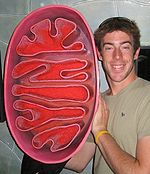Difference between revisions of "Herbst 2014 Abstract MiP2014"
Beno Marija (talk | contribs) |
|||
| (4 intermediate revisions by 2 users not shown) | |||
| Line 1: | Line 1: | ||
{{Abstract | {{Abstract | ||
|title=Analysis of mitochondrial function in multiple brain regions through ''in situ'' permeabilization | |title=Analysis of mitochondrial function in multiple brain regions through ''in situ'' permeabilization. | ||
|info=[[File:Herbst_E.jpg|150px|right|Herbst | |info=[[File:Herbst_E.jpg|150px|right|Herbst EAF]] [[Laner 2014 Mitochondr Physiol Network MiP2014|Mitochondr Physiol Network 19.13]] - [http://www.mitophysiology.org/index.php?mip2014 MiP2014] | ||
|authors=Herbst | |authors=Herbst EA, Holloway GP | ||
|year=2014 | |year=2014 | ||
|event=MiP2014 | |event=MiP2014 | ||
|abstract=Mitochondria interact with their environment in a tissue-specific manner, and in the brain, the regulation of mitochondrial function is regionally unique. Analysis of mitochondrial respiration within the brain is traditionally assessed through utilization of isolated mitochondria, an approach with high tissue requirements that limit the applicability of the method in investigating function in smaller brain regions. This tissue limitation impedes the study of neurodegenerative diseases, which are often attributed to mitochondrial dysregulation within smaller specific brain regions. In addition, isolating mitochondria interrupts the native reticular structure of the mitochondria and also yields a final suspension composed of mitochondria from multiple sub-populations from various cell types, making physiological interpretations challenging. Therefore, the current methodology does not appear adequate for investigating the source of changes in brain mitochondrial function. | |abstract=Mitochondria interact with their environment in a tissue-specific manner, and in the brain, the regulation of mitochondrial function is regionally unique. Analysis of mitochondrial respiration within the brain is traditionally assessed through utilization of isolated mitochondria, an approach with high tissue requirements that limit the applicability of the method in investigating function in smaller brain regions. This tissue limitation impedes the study of neurodegenerative diseases, which are often attributed to mitochondrial dysregulation within smaller specific brain regions. In addition, isolating mitochondria interrupts the native reticular structure of the mitochondria and also yields a final suspension composed of mitochondria from multiple sub-populations from various cell types, making physiological interpretations challenging. Therefore, the current methodology does not appear adequate for investigating the source of changes in brain mitochondrial function. | ||
As a result, we established a method for determining mitochondrial function in situ through permeabilization of small brain samples of approximately 2 mg. The method was validated through electron transfer | As a result, we established a method for determining mitochondrial function in situ through permeabilization of small brain samples of approximately 2 mg. The method was validated through electron transfer-pathway complex-specific stimulation and inhibition, and imaging confirmed conservation of mitochondrial morphology. We applied the permeabilized brain tissue preparation to investigating regional variation in mitochondrial function in the mouse brain with both acute and chronic perturbations and compared our results with the traditional isolated mitochondria preparation. | ||
The permeabilization of brain tissue in situ circumvents the large tissue requirements of isolated mitochondria while leaving the native mitochondrial intact, allowing for analysis of mitochondrial respiration in multiple regions in a single mouse brain. | The permeabilization of brain tissue in situ circumvents the large tissue requirements of isolated mitochondria while leaving the native mitochondrial intact, allowing for analysis of mitochondrial respiration in multiple regions in a single mouse brain. | ||
|mipnetlab=CA Guelph Holloway GP | |mipnetlab=CA Guelph Holloway GP | ||
| Line 14: | Line 14: | ||
|organism=Mouse | |organism=Mouse | ||
|tissues=Nervous system | |tissues=Nervous system | ||
|preparations=Permeabilized tissue, Isolated | |preparations=Permeabilized tissue, Isolated mitochondria | ||
|couplingstates=OXPHOS | |couplingstates=OXPHOS | ||
|instruments=Oxygraph-2k | |instruments=Oxygraph-2k | ||
Latest revision as of 15:22, 20 October 2017
| Analysis of mitochondrial function in multiple brain regions through in situ permeabilization. |
Link:
Mitochondr Physiol Network 19.13 - MiP2014
Herbst EA, Holloway GP (2014)
Event: MiP2014
Mitochondria interact with their environment in a tissue-specific manner, and in the brain, the regulation of mitochondrial function is regionally unique. Analysis of mitochondrial respiration within the brain is traditionally assessed through utilization of isolated mitochondria, an approach with high tissue requirements that limit the applicability of the method in investigating function in smaller brain regions. This tissue limitation impedes the study of neurodegenerative diseases, which are often attributed to mitochondrial dysregulation within smaller specific brain regions. In addition, isolating mitochondria interrupts the native reticular structure of the mitochondria and also yields a final suspension composed of mitochondria from multiple sub-populations from various cell types, making physiological interpretations challenging. Therefore, the current methodology does not appear adequate for investigating the source of changes in brain mitochondrial function. As a result, we established a method for determining mitochondrial function in situ through permeabilization of small brain samples of approximately 2 mg. The method was validated through electron transfer-pathway complex-specific stimulation and inhibition, and imaging confirmed conservation of mitochondrial morphology. We applied the permeabilized brain tissue preparation to investigating regional variation in mitochondrial function in the mouse brain with both acute and chronic perturbations and compared our results with the traditional isolated mitochondria preparation. The permeabilization of brain tissue in situ circumvents the large tissue requirements of isolated mitochondria while leaving the native mitochondrial intact, allowing for analysis of mitochondrial respiration in multiple regions in a single mouse brain.
• O2k-Network Lab: CA Guelph Holloway GP
Labels: MiParea: Respiration
Organism: Mouse
Tissue;cell: Nervous system
Preparation: Permeabilized tissue, Isolated mitochondria
Coupling state: OXPHOS
HRR: Oxygraph-2k Event: A4, Oral MiP2014
Affiliation
Dep Human Health Nutritional Sc, Univ Guelph, Ontario, Canada. - eherbst@uoguelph.ca
